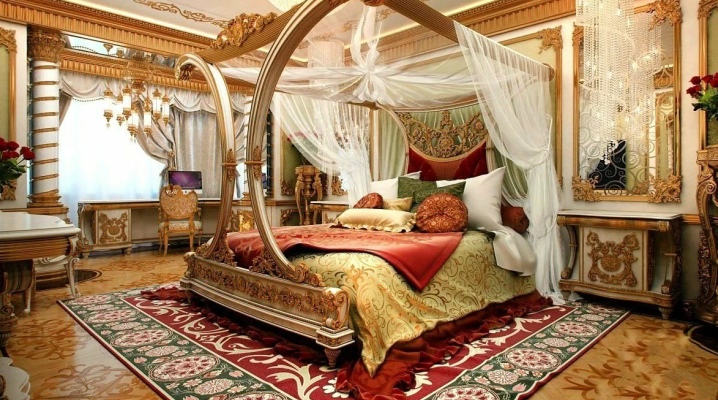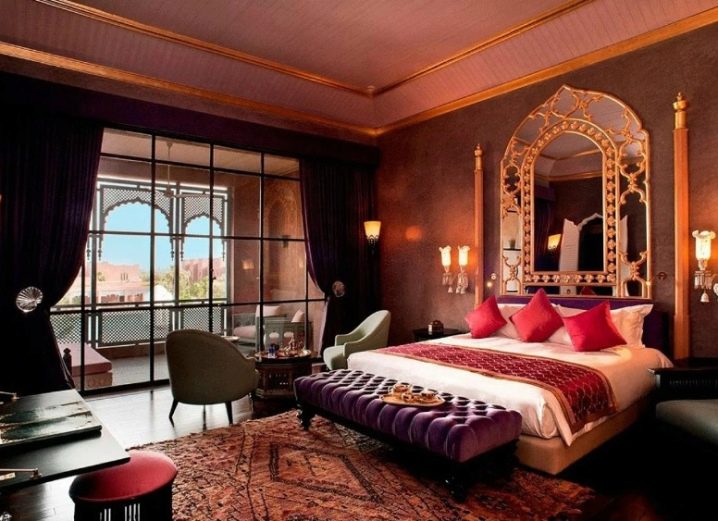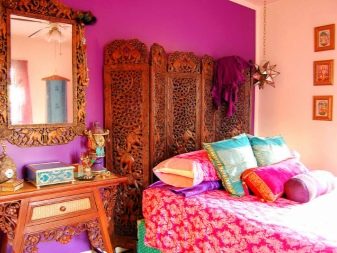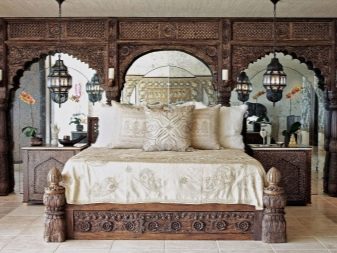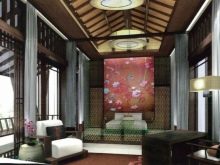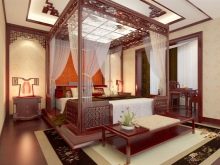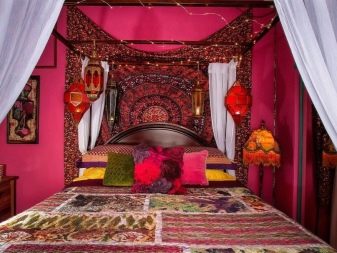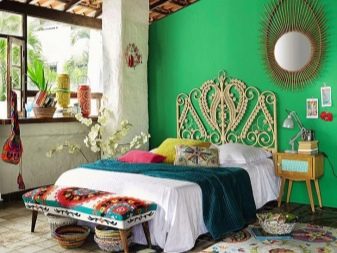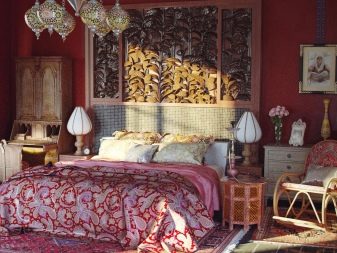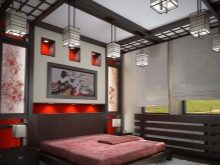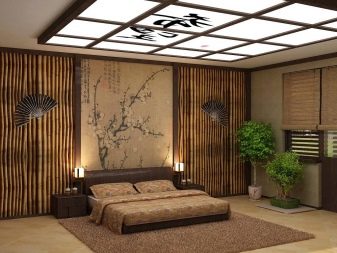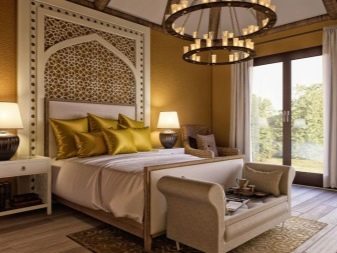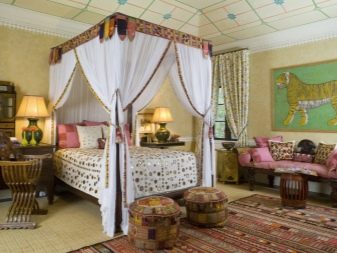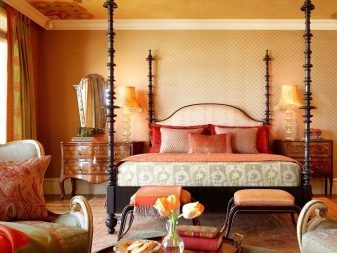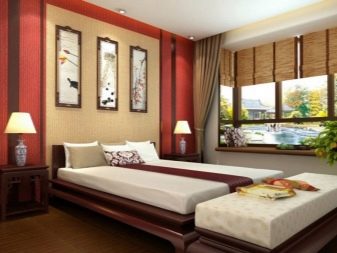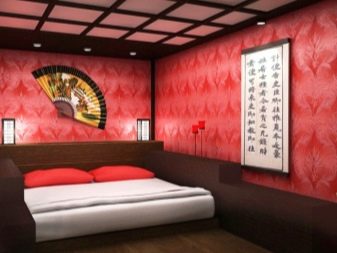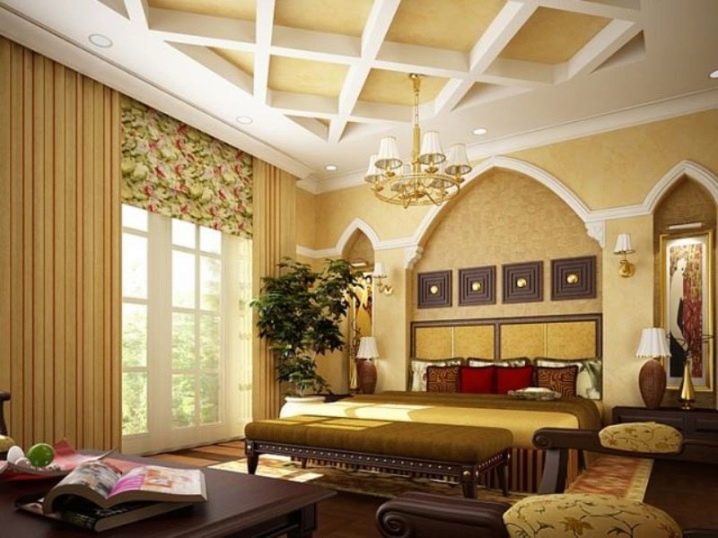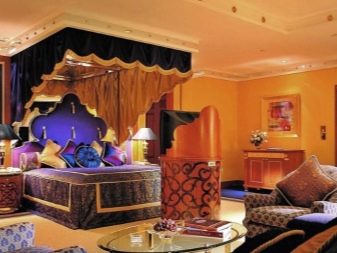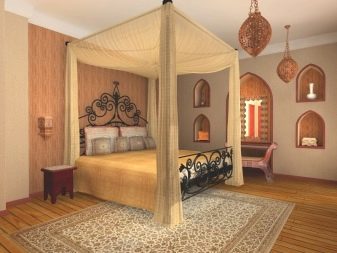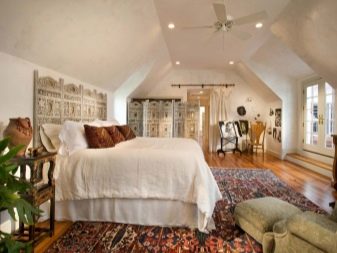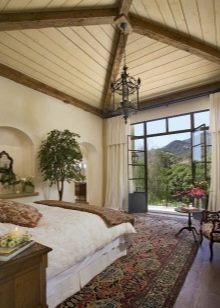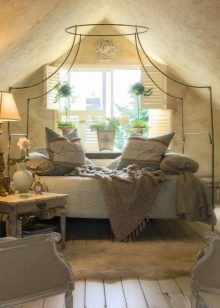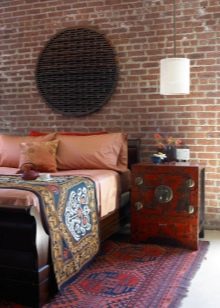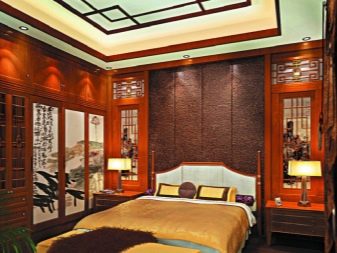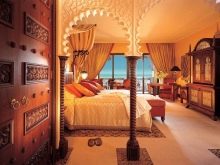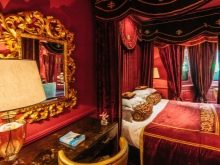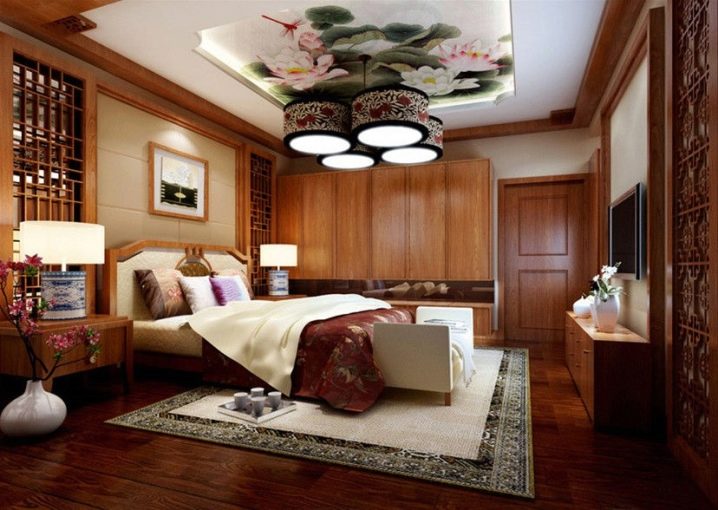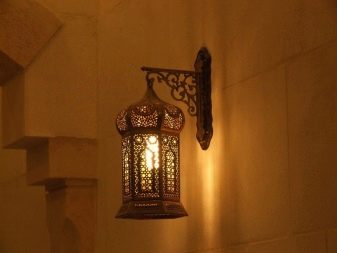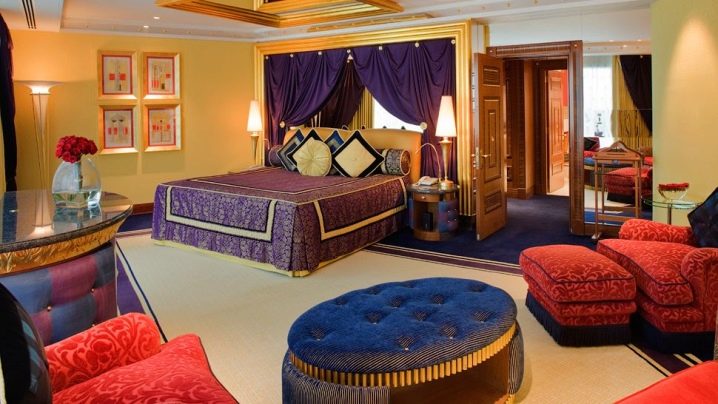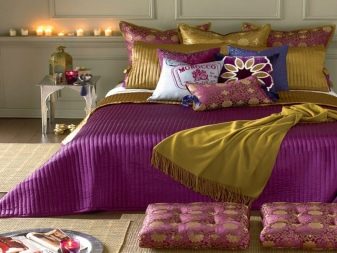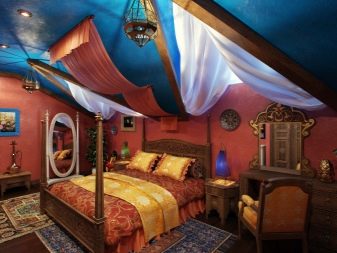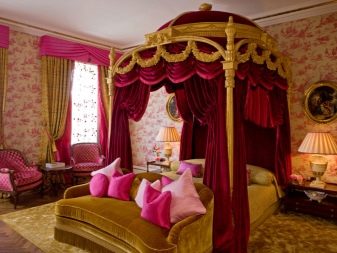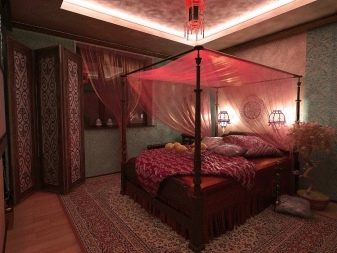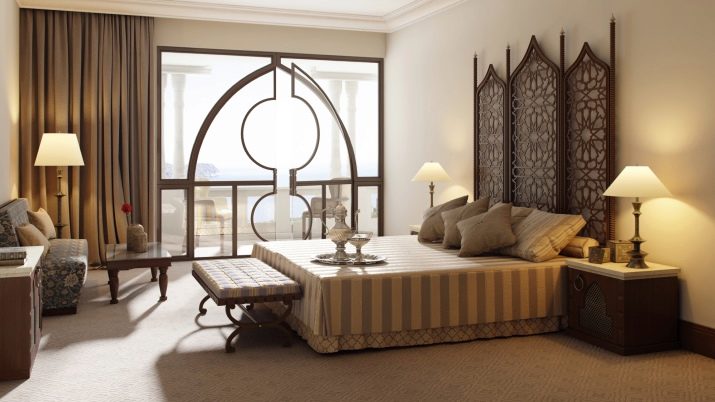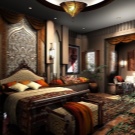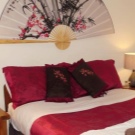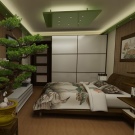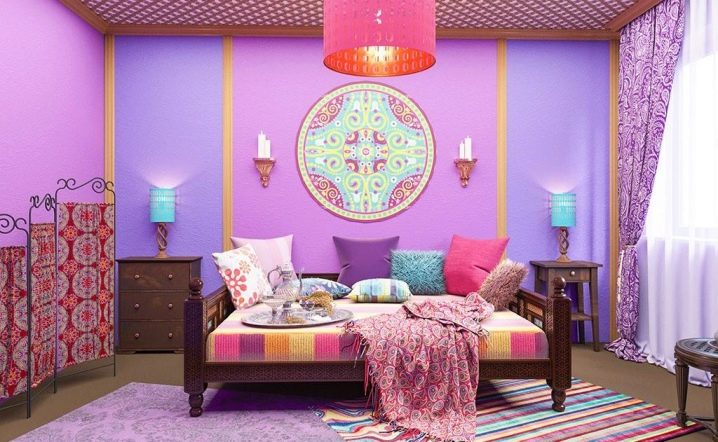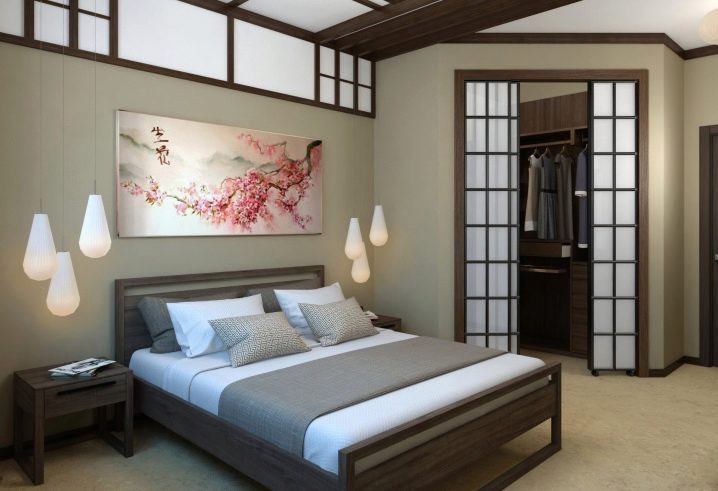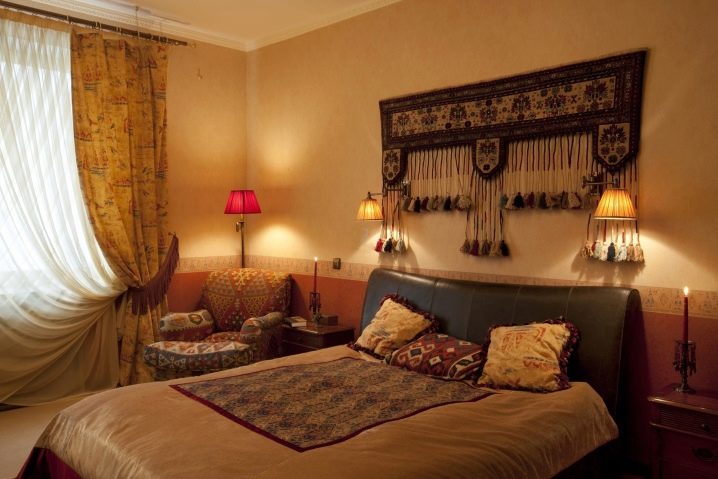Methods for decorating bedrooms in oriental style
An oriental-style bedroom is always associated with luxury and wealth. The concept of the East in design is versatile. When creating such an interior, national decor elements of any country from Japan to Morocco can be used. However, there are certain rules that are taken as a basis. This applies to interior items, lighting options, general color schemes and textiles.
Peculiarities
To create a bedroom in an oriental style, you do not need a major overhaul of the room. The required atmosphere can be created even in a small space. The main thing is to follow certain design rules. The oriental style implies the obligatory presence of some components:
-
a large number of pillows that can be placed on the bed, on additional furniture and even on the floor;
-
figurines that create a special atmosphere (you can place them on shelves, dressers);
-
rich palette of colors, which can combine the brightest and most saturated colors;
-
maximum use of textiles in the form of lambrequins, heavy curtains;
-
the use of only natural materials for decoration (for example, bamboo or stone);
-
layering in the design of windows and walls (several curtains, carpets, superimposed on each other).
Overview of style directions
When carrying out repairs, it is important to take into account that the design of the modern East has several directions. Each of them differs in some details and interior design rules. For some, minimalism is characteristic, for others - the maximum number of accessories, interior decorations and decorative trim elements.
Indian
The brightest and most cheerful direction of all oriental styles. The characteristic details for this design are ivory décor elements, forged products and natural wood.
Otherwise, when creating an interior, it is important to follow traditional rules - a large number of different textiles, pillows, canopies over the bed.
Peculiarities:
-
you can combine the brightest shades, but they should look harmonious with each other;
-
it is permissible to use textiles instead of wall carpets;
-
the use of numerous decorative elements, for example, figurines, is characteristic.
Japanese
The Japanese trend is characterized by minimalism and adherence to the principle of unity with nature. Beauty and harmony in this case are manifested not in luxurious and expensive elements, but in maximum simplicity.
Floral patterns prevail in the decoration of the walls. Often, when creating a Japanese interior, sliding structures (entrance doors, wardrobes) are used.
Other features:
-
when you are in the bedroom, you should feel lightness and a kind of airiness;
-
the amount of furniture should be minimal.
Moroccan
One of the most unusual is the Moroccan style for the bedroom. This destination combines European and African cultures. For him, the main qualities are beauty, versatility and comfort.
In bedrooms, you can often see bedside benches or bedside tables, pillows on the floor as a place to rest.
Other features:
-
use of mosaics to decorate walls, floors and windows (stained glass);
-
the presence of rough interior items, including national attributes in the form of bizarre figurines;
-
the use of the most unusual geometry for doorways and ceilings;
-
an abundance of threads on any smooth surfaces.
Chinese
Chinese-style interior design is considered to be quite a daunting task for designers. This nuance is due to the peculiarities of culture. Each piece of furniture, pattern or additional accessories has its own meaning. The practice of feng shui is taken as a basis.
Peculiarities:
-
the location of the bed in a certain direction;
-
placement of all interior items according to Feng Shui recommendations;
-
maximum restraint and harmony are considered distinctive features.
Turkish
The characteristic features of a Turkish bedroom are a low bed and a large number of pillows. Special attention is paid to textiles. Curtains should match the color of the bed. The floor should be covered with a bright and fluffy carpet. It plays the role of not only decoration, but also a place for temporary rest. Following the tradition, you can, for example, put pillows on it and relax after hard working days.
Other nuances:
-
an abundance of embroidery on bedspreads, curtains, pillows in the Turkish style;
-
the bedspread must be bright;
-
for curtains, the principle of layering and the presence of a lambrequin are used.
Arab
Islam and ancient traditions have greatly influenced the Arabic style. Its distinctive characteristic is the presence of a large number of all kinds of geometric shapes and ornaments. Live images cannot be used. This nuance is due to the influence of Islam. That is why painting or elements made in sculptural technique are never used in the Arabian style.
Other features:
-
the presence of a large number of textiles and pillows;
-
using a tent or canopy over the bed;
-
lack of mirrors in the bedroom;
-
decoration of the floor and walls with massive carpets.
Materials and finishes
It is strictly forbidden to use artificial materials (for example, plastic) to decorate a bedroom in an oriental style. Wooden elements should prevail in such an interior. Finishing materials are considered a kind of base or foundation. The stage of choosing materials should be approached with special attention and responsibility.
Nuances:
-
to cover the floor, you can use stone, tiles, laminate, natural carpet (it is great if initially there will be an oriental ornament on the material);
-
a carpet is always laid on the floor (if possible, then you need to purchase a handmade product);
-
light laminate is acceptable only for Japanese and Chinese trends in interior design;
-
the walls should have textiles or other material with traditional patterns;
-
a uniform and restrained color scheme with a minimum amount of decor is typical only for Japanese and Chinese styles;
-
the ceiling should always be made in light colors; the use of suspended wooden beams is permissible;
-
an interesting technique is considered to be the decoration of the ceiling with drapery using silk textiles.
Furniture selection
When choosing furniture, it is important to consider the original size of the room. If the bedroom is small, then the interior items should be in light colors. It is better to replace bulky cabinets with spacious, but small dressers. Such items, on the one hand, play the role of a place for storing things, on the other hand, they are decoration.
For a large bedroom:
-
the main piece of furniture is the bed, which must be large and always with textile pillows;
-
you can divide the zones with screens and canopies;
-
furniture can have any dimensions, but must correspond to the chosen direction of style;
-
wooden shelves are considered a must for all oriental styles.
Color solutions
The predominant colors in the oriental style are red, purple, blue and green. However, this design direction allows a combination of almost any shade. The main nuance is the correspondence of the color scheme to a specific style. For example, for the Indian version, you can use the most daring combinations, but for the Japanese - only brown, beige or gray tones, as close as possible to naturalness.
Color options:
-
a combination of a red background and numerous golden elements;
-
light green, beige, cream, bamboo and grassy colors go well with each other and can be used at the same time.
Organization of lighting
The selection of lighting for the bedroom is carried out in accordance with two rules:
-
the ability, if necessary, to create maximum light;
-
the presence of the function to muffle it, making the atmosphere mysterious and mysterious.
This effect is achieved due to modern options for lighting devices with several modes.
Other nuances:
-
there should be separate lamps at the head of the bed, on bedside tables or above dressers;
-
there are numerous spotlights or one large chandelier on the ceiling.
Decor elements and textiles
Various decorative elements play a special role in the oriental style.
Cushions
There should be a lot of pillows, they serve as decoration, a kind of resting place. In the oriental style, the use of chairs in the bedroom is unacceptable. Their pillows are fully replaced.
Textile
Maximum amount of textiles. Natural fabrics are used to create multi-layer curtains, replace carpets, and even are used to decorate the ceiling.
The most common fabrics used are:
-
velvet;
-
silk;
-
brocade.
Themed accessories should be used as decorative elements. For example, national weapons, vases with scented candles, jewelry boxes with stones or exquisite carvings. Unusual lamps, wrought iron elements, paintings with traditional ornaments are also considered almost indispensable elements in the bedroom. Living plants such as dwarf species, bamboo, or bonsai plants are acceptable.
Examples of interiors
An Indian-style bedroom is always distinguished by an abundance of bright colors. Pillows, a large amount of textiles and rather high berths are considered mandatory elements.
The Japanese-style bedroom is characterized by low beds and minimalism in the interior. It is permissible to use national ornaments for decoration. Materials are always used only natural.
The use of brushes is a very common technique. They can be placed on curtains, on a canopy. Numerous pillows with tassels look beautiful.
